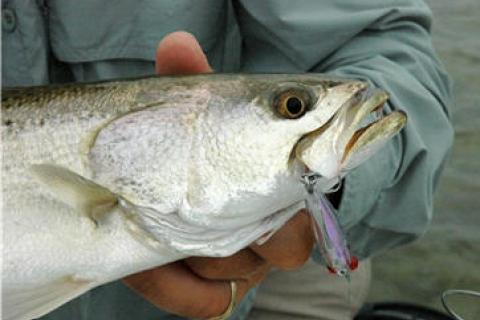
Spotted seatrout, aka speckled trout or just plain "trout," are among the most abundant and prolific of inshore fish species throughout much of their range along the coast of the southeastern U.S. They are also one of the easiest to catch.
That is, they're easy to catch until they reach a length of 20 inches and up — then they become a serious challenge in most areas most of the time. Lunker trout, known as "yellow mouths" because the mature fish develop a gold color around their jaws, and also as "gators" because of their pronounced canine teeth, are smart and cautious. In addition, they are considerably less abundant then their smaller relatives; a 10-pounder is a lifetime trophy.
 |
| When found in clear, shallow water, lunker spotted seatrout can be among the most challenging targets in all of inshore angling. |
However, there are some tactics that can put the odds in your favor. Here are a few passed on to me over the years by Florida anglers who specialize in pursuing these giants:
 |
| Tossing big, noisy topwater lures is one way to fool big trout when they’re found in shallow grass flats. |
- In many areas, the largest seatrout are found in surprisingly shallow water: depths of three feet and less attract these lunkers, and sometimes they show up in water barely ankle deep.
- They frequently travel with schools of mature mullet, apparently feeding on creatures pushed out of the grass by the "mudding" of these grazers.
- Topwaters such as the Bass Pro Shops XPS Walker, the Heddon Super Spook and the 7 M Mirrolure, worked in the classic "walkin' the dog" zigzag are among the best lures to fool big seatrout.
- Soft plastic jerkbaits such as the Offshore Angler XPS Soft Salty Shad and the Z-Man SwimmerZ rigged weedless can also work well, particularly where grass makes it tough to throw a treble-hook lure.
- Low impact lures such as the DOA Shrimp are the ticket in shallow, clear water where more obnoxious lures may spook the fish.
- Lunker seatrout are extremely wary when found in shallow water: a silent approach is a must, and by far the best way to get into range is to get out of the boat and wade. (A pair of wading booties like the World Wide Sportsman Flats Boots makes this a whole lot more comfortable than trying it in your sneakers.)
- In chilly weather, big trout also frequently school around nearshore cover — boat wrecks and rock piles sometimes hold large schools at depths of 8 to 10 feet. In some areas, the fish also move into coastal rivers and settle into oystery potholes in the backcountry.
- Biologists report that mature seatrout feed mostly on baitfish rather than on shrimp, so keep this in mind in your lure selection. (However, in winter many types of baitfish become scarce, and in most areas the trout revert to feeding on shrimp so go with the flow.)
Lunker seatrout are an interesting challenge and make great braggin' photos to post to your angling buddies. But remember it takes more than a decade for that rare 10-pound female to reach maximum size, and she and her sisters are the future of the fishery. Treat her with care, get your photos promptly and release her carefully. She's a lot more valuable in the water than in the fryer.
Learn topwater tactics for seatrout at Bass Pro Shops 1Source.
- 4836 views

